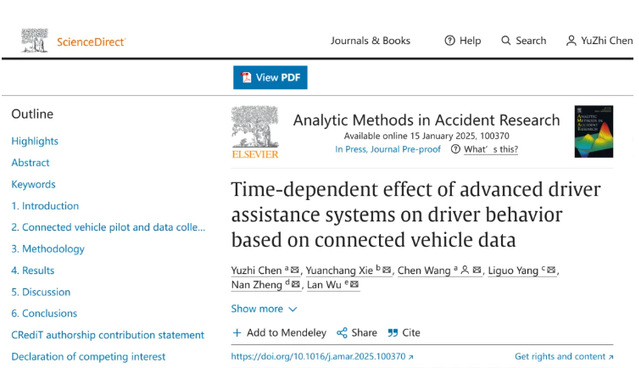Recently, a research team led by Professor Wang Chen, Deputy Director of the University's Office of International Cooperation, in collaboration with Professor Xie Yuanchang's team from the University of Massachusetts Lowell (USA) and Professor Zheng Nan's team from Monash University (Australia), has made significant progress in quantitative research on the effectiveness of Advanced Driver Assistance Systems (ADAS).

The study proposed a novel Functional Data Analysis (FDA) approach capable of effectively revealing the time-dependent intervention effects of ADAS on drivers' reactive behaviors. This methodology holds potential to establish a technical paradigm for quantifying the functional efficacy of ADAS implementations. The findings are expected to contribute to the improvement of personalized ADAS designs and facilitate the development and calibration of driving behavior models for ADAS applications.
This study validated the effectiveness and superiority of the proposed methodology using 5,441 forward collision warning events from the New York City Connected Vehicle Pilot Development (NYC-CVPD) program. The findings revealed that:
The intervention effect of warning signals does not monotonically decrease over time; instead, it rapidly strengthens to a peak initially, then gradually declines until dissipation.
Aggregate metrics have limited utility in understanding driving behavior, as they may obscure intervention effects on driving actions at specific time points and are prone to statistical insignificance due to behavioral heterogeneity.
At a 95% confidence level, driver reaction behavior comprises four phases: Reaction Time (RT, 1.3 seconds), Brake Adjustment Time (BAT, 1.3 seconds), Stable Braking Duration (PBD, 2.7 seconds), and Effective Intervention Duration (ETD, 4.0 seconds).
The width of coefficient confidence intervals varies over time, highlighting behavioral heterogeneity across distinct reaction phases.
Six heterogeneous driving behavior response patterns were identified: Compared to baseline levels, drivers with longer PBD and ETD tend to adopt cautious deceleration to ensure vehicle stability and safety, whereas those with shorter PBD and ETD exhibit aggressive deceleration. Notably, Reaction Time (RT) alone is insufficient to explain the aggressiveness of behavioral responses.
This research achievement, titled Time-dependent effect of advanced driver assistance systems on driver behavior based on connected vehicle data, has been published in Analytic Methods in Accident Research—a leading journal in traffic safety (CiteScore = 22.1, Impact Factor = 12.5).